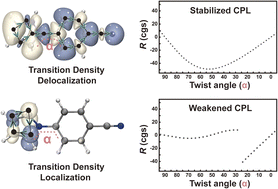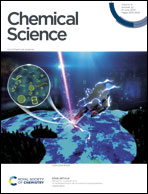Pivotal role of transition density in circularly polarized luminescence†
Abstract
Realizing high luminescence dissymmetry factor (g) in circularly polarized luminescence (CPL) materials remains a big challenge, which necessitates understanding systematically how their molecular structure controls the CPL. Here we investigate representative organic chiral emitters with different transition density distributions and reveal the pivotal role of transition density in CPL. We rationalize that to obtain large g-factors, two conditions should be simultaneously satisfied: (i) the transition density for the S1 (or T1)-to-S0 emission must be delocalized over the entire chromophore; and (ii) the chromophore inter-segment twisting must be restricted and tuned to an optimal value (∼50°). Our findings offer molecular-level insights into the CPL of organic emitters, with potential applications in the design of chiroptical materials and systems with strong CPL effects.



 Please wait while we load your content...
Please wait while we load your content...